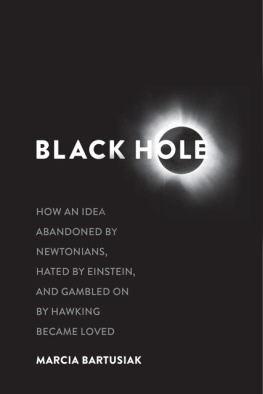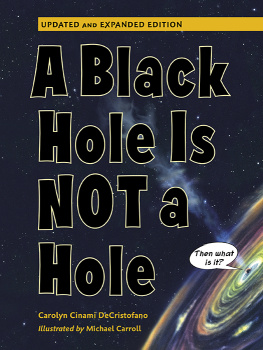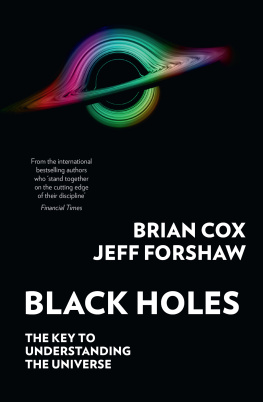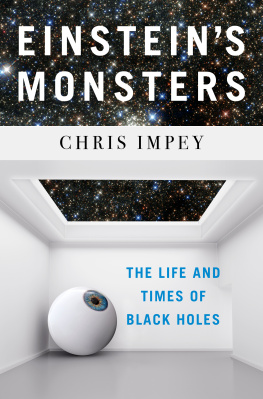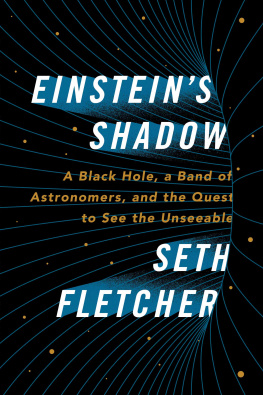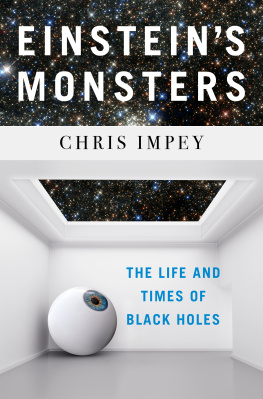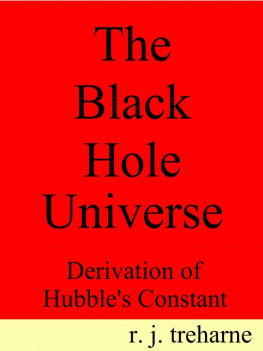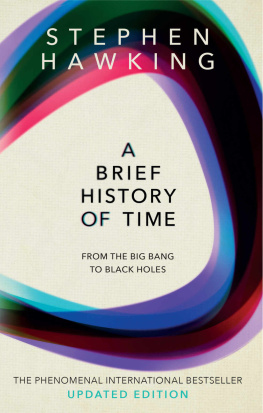

Copyright 2015 by Marcia Bartusiak.
All rights reserved. This book may not be reproduced, in whole or in part, including illustrations, in any form (beyond that copying permitted by Sections 107 and 108 of the US Copyright Law and except by reviewers for the public press), without written permission from the publishers.
Yale University Press books may be purchased in quantity for educational, business, or promotional use. For information, please e-mail (UK office).
Printed in the United States of America.
Library of Congress Cataloging-in-Publication Data
Bartusiak, Marcia, 1950
Black hole: how an idea abandoned by Newtonians, hated by Einstein, and gambled on by Hawking became loved / Marcia Bartusiak.
pages cm.
Includes bibliographical references and index.
ISBN 978-0-300-21085-9 (clothbound : alk. paper)
1. Black holes (Astronomy). 2. Discoveries in science. 3. ScienceSocial aspects. I. Title.
QB843.B55B37 2015 523.8875dc23
2014038950
A catalogue record for this book is available from the British Library.
This paper meets the requirements of ANSI/NISO Z39.481992 (Permanence of Paper).
10 9 8 7 6 5 4 3 2 1
Dedicated to my students, past and present, in the Graduate Program in Science Writing at the Massachusetts Institute of Technology, who daily inspire me
Contents
Black Holes Aint So Black
Preface
The very notion of a black hole is so alluring. It combines the thrill of the unknown with a sense of lurking danger and abandon. To imagine a journey to a black holes outer boundary is like approaching the precipice of Niagara Falls, contemplating the vertical plunge to the churning waters below, yet remaining secure in the knowledge that were positioned behind a sturdy fence to keep us from peril. Even in the real world, we know were safe, as the closest black holes to Earth are thankfully hundreds of light-years distant. So, we experience the dark, celestial adventure vicariously.
For any astrophysicist at a cocktail party, its the cosmic object theyre most likely to be asked about. And for good reason: a black hole is wackily weird. As noted black-hole expert and Caltech theorist Kip Thorne has written, Like unicorns and gargoyles, black holes seem more at home in the realms of science fiction and ancient myth than in the real Universe.
University of Texas astrophysicist J. Craig Wheeler calls them a cultural icon. Nearly everyone understands the symbolism of black holes as yawning maws that swallow everything and let nothing out, he says.
And it was the same stark and alien weirdness, now celebrated, that kept physicists from accepting black holes for decades on end. According to a famous saying, often quoted, All truth passes through three stages: First, it is ridiculed; second, it is violently opposed; and third, it is accepted as being self-evident. The concept of the black hole fully experienced each and every phase.
Its the black hole that forced both astronomers and physicists to take Albert Einsteins most notable achievementgeneral relativityseriously. For a time the theory had entered a valley of despair. Einstein was honored as the Person of the Twentieth Century by Time magazine, yet such an honor would have been a huge surprise to the scientific community in midcentury. In that era, few universities in the world even taught general relativity, believing it had no practical applications for physicists. The best and the brightest flocked to other realms of physics. After the flurry of excitement in 1919, when a famous solar eclipse measurement triumphantly provided the proof for Einsteins general theory of relativity, the noted physicists new outlook on gravity came to be largely ignored. Isaac Newtons take on gravity worked just fine in our everyday world of low velocities and normal stars, so why be concerned with the minuscule adjustments that general relativity offered? What was its use? Einsteins predictions refer to such minute departures from the Newtonian theory, noted one critic, that I do not see what all the fuss is about. After a while, Einsteins revised vision of gravity appeared to have no particular relevance at all. By the time that Einstein died, in 1955, general relativity was in the doldrums. Only a handful of physicists were specializing in the field. As Nobel laureate Max Born, a longstanding and intimate friend of Einstein, confessed in a conference the year of Einsteins death, general relativity appealed to me like a work of art, to be enjoyed and admired from a distance.
But in reality what Einstein had done was devise a theory that was decades ahead of its time. Experimental measurements had to catch up to his model of gravity, which had been fashioned from pure intuitive thought. Not until astronomers revealed surprising new phenomena in the universe, brought about with advanced technologies, did scientists take a second and more serious look at Einsteins view of gravity. Observers identified in 1963 the first quasar, a remote young galaxy disgorging the energy of a trillion suns from its center. Four years later, much closer to home, observers stumbled upon the first pulsar, a rapidly spinning beacon emitting staccato radio beeps. Meanwhile space-borne sensors spotted powerful X-rays and gamma rays streaming from points around the celestial sky. All these new and bewildering signals pinpointed collapsed stellar objectsneutron stars and black holeswhose crushing gravity and dizzying spins turn them into extraordinary dynamos. With the detection of these new objects, the once sedate universe took on a racy edge; it metamorphosed into an Einsteinian cosmos, filled with sources of titanic energies that can be understood only in the light of relativity.
And what astrophysicists ultimately discovered and came to appreciate was general relativitys deeper aesthetic appeal, especially when it came to black holes. They are, said Subrahmanyan Chandrasekhar on receiving the Nobel Prize in physics in 1983, the most perfect macroscopic objects there are in the universe. Black holes offered all that a physicist yearned for in a theoretical outcome: both simplicity and beauty. Beauty, Chandrasekhar told the audience, is the splendor of truth.
Where once the field of general relativity was a cozy backwater, it now flourishes, both in theory and in practice. The black hole is no longer an oddity but a vital component of the universe. Nearly every fully developed galaxy appears to have a supermassive black hole at its center; it may be that the very existence of a galaxy depends on it. Telescopes are currently closing in on the gargantuan hole that resides in the heart of our home galaxy, the Milky Way. At the same time, cutting-edge observatories, newly designed, stand ready to detect the space-time rumblesgravity wavesemitted when black holes collide somewhere in our intergalactic neighborhood. As John Archibald Wheeler, a dean of American relativity, once noted in the dedication of his autobiography, We will first understand how simple the universe is when we recognize how strange it is.
But arriving at that knowledge took more than two hundred yearsfrom the precursor of the black-hole idea in the 1780s to observational proof in the latter half of the twentieth century. And for most of that time, the very notion of this strange entitys presence in the cosmos was either ignored or earnestly fought against. Physicists conceded the black holes existence only after a lot of virtual kicking and screaming.
In hindsight, its difficult to understand why they put up such a struggle. The idea of the black hole is actually quite simple. It has a mass, and it has a spin. In some ways, its as elementary an entity as an electron or a quark. But what confounded physicists for so long was the black holes ultimate nature: its matter squeezed to a point. Their fight against such an outcome for a star was more philosophy than science; they deeply believed nature wouldnt (couldnt!) act in such a crazy way. It took a handful of physicists over that lost half century to swim against the current and push the idea forward, crazy or not. Now, in celebration of general relativitys hundredth anniversary in 2015, here is the story of that frustrating, resourceful, exhilarating, and (at times) humorous struggle toward acceptance. This is neither the anatomy of a black hole nor a report on the latest astronomical and theoretical findings. This is the history of an idea.
Next page
